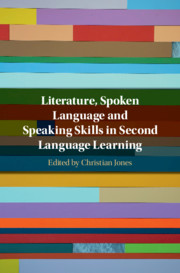Book contents
- Literature, Spoken Language and Speaking Skills in Second Language Learning
- Literature, Spoken Language and Speaking Skills in Second Language Learning
- Copyright page
- Contents
- Figures and Tables
- Contributors
- Foreword
- Acknowledgements
- 1 Introduction
- Part I Literature and Spoken Language
- Part II Literature and Speaking Skills
- 7 EFL Learners Reading and Discussing Poems in English
- 8 An Analysis of Collaborative Dialogue in Literature Circles
- 9 Exploring Literary Texts as a Tool for Developing L2 Oral Proficiency
- 10 Conclusion: Implications for Pedagogy and Research
- Index
- References
10 - Conclusion: Implications for Pedagogy and Research
from Part II - Literature and Speaking Skills
Published online by Cambridge University Press: 18 October 2019
- Literature, Spoken Language and Speaking Skills in Second Language Learning
- Literature, Spoken Language and Speaking Skills in Second Language Learning
- Copyright page
- Contents
- Figures and Tables
- Contributors
- Foreword
- Acknowledgements
- 1 Introduction
- Part I Literature and Spoken Language
- Part II Literature and Speaking Skills
- 7 EFL Learners Reading and Discussing Poems in English
- 8 An Analysis of Collaborative Dialogue in Literature Circles
- 9 Exploring Literary Texts as a Tool for Developing L2 Oral Proficiency
- 10 Conclusion: Implications for Pedagogy and Research
- Index
- References
Summary
This aim of thisis to draw together the different threads and summarise what we can learn from the chapters in this volume and also attempt to identify ways forward in both research and teaching. The conclusions I draw aim to be instructive and reflective rather than didactic. The purpose of this volume has been to investigate the potential of using literature to develop awareness of spoken language or speaking skills and, as noted, there have only been a limited number of studies in this area. These findings then need to be developed by other researchers or taken forward and adapted by teachers in their own contexts. Despite these caveats, I feel there are some useful conclusions we can draw from the chapters presented.
This chapter takes the following form: it first lists and discusses five implications for teaching and then five for research. As each implication is discussed, explicit reference will be made to the chapters in this book and their findings, and it is hoped that these implications provide suggestions for teaching and research.
- Type
- Chapter
- Information
- Publisher: Cambridge University PressPrint publication year: 2019



